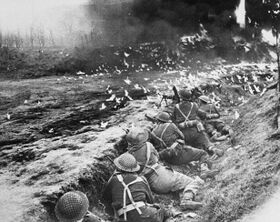Pakistania Offensive
This article is incomplete because it is pending further input from participants, or it is a work-in-progress by one author. Please comment on this article's talk page to share your input, comments and questions. Note: To contribute to this article, you may need to seek help from the author(s) of this page. |
| Pakistania Offensive | |||||||
|---|---|---|---|---|---|---|---|
| Part of the Middle East Campaign of the Second Europan War | |||||||
 Lucian Troops dig in during Objective R30 | |||||||
| |||||||
| Belligerents | |||||||
| Commanders and leaders | |||||||
| Strength | |||||||
|
110,000 troops 150 tanks 300 aircraft 100 guns |
200,000 troops 400 tanks 500 aircraft 250 guns | ||||||
| Casualties and losses | |||||||
| Heavy | Heavy | ||||||
The Pakistania Offensive (20 June - 28 August 1942) was an Imperial offensive launched on 20 June 1942. Planned by Quenminese Marshal Mạc Hiếu Quang, the plan called for the bulk of Imperial forces in the Southern and Northern Pakistania to push Allied forces back, and potentially split Allied fronts in Afghania in two. The Imperial plan was unexpected with Imperial forces in the North pushing the Allies towards the Adibotara Crater, while the Imperial push in the south was aimed at Kantabash. In theory, Marshal Quang's plan was to wholly encircle Sugiyama's forces at Kabul that would see a 600,000 army strong force to be surrounded on all sides and pressured into surrender.
Opening actions saw Imperial forces in the southern sector push the Allies out of Balochistan while at Kashrul, the Allies were pushed further away from the capital region. Sugiyama was denied the ability to dig in and was subsequently forced back at Kabul, where he decided to dig in his central and what remained of the northern flank. By 1 August, the Imperials engaged with elements of the Bethausian forces at the Adibotara Crater, just a few miles away from the Nuristan Forest. Immediately, General Phó Minh Duyên commenced tobedar tactics that almost trapped the Bethausian forces into the crater but were saved thanks to a delaying action that allowed the Bethausian forces to escape. By 1 August, Imperial forces were now less than 70kms from Kabul, and less than 250kms from the eastern edge of the Elyagan Valley.
Although the Imperials had largely succeeded in pushing the Allies back, the constant raids on Imperial supply lines meant that Quang's forces would need to pause so that supplies and fuel can arrive. This opportunity gave Sugiyama the opportunity the establish defences near Route 30. Coincidentally, Imperial General Alexander Sundermann suggested to push the Allies further back in the south by means of commencing a northwestern thrust through the town of Kantabash along Route 30. Seeing that a thrust to the northwest from the south would hasten Sugiyama's encirclement, Marshal Quang agreed and by 12 August, the Imperials began the fourth phase of their offensive. But when the attack came, Imperial forces were greeted by stiff resistance from ZANAC forces. Although outnumbered, Zanarkian General Leslie Oliver Morshead succeeded in blunting Quang's thrust, saving Sugiyama from encirclement. This caused Quang to abandon his plan of dagger-thrusting to the Elyagan Valley and instead commence an encirclement of Sugiyama's force near Kabul, with General Kiều Dũng Quang taking Mazahr-Sharif to the north before swinging south towards the capital.
The Pakistania Offensive had denied Sugiyama of the ability to wage war in the Pakistania Lowlands, forcing him plan out his offensive towards the Nepali Mountains. The offensive in total had left the Allies initially in disarray but Sugiyama regained the initiative, ordering his forces to absorb the Imperial blows towards the Afghanian capital in order to wage a war of attrition, for which the Imperial commanders were not ready. By the time the offensive had ended, the Battle of Mazahr-Sharif took place afterwards in order to secure Sugiyama's encirclement, by which at that time, the Taoyuanese forces led by General Song Li-jen waged an offensive maneuver to prevent the encirclement from taking place long enough for Generals Regnitz and Testarossa's 2nd ERUIF to arrive and prevent Sugiyama's encirclement at Kabul.